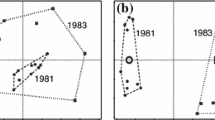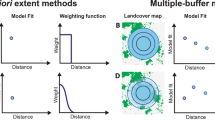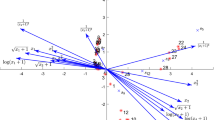Abstract
Detrending and non-linear axis rescaling potentially improve the accuracy of gradient recovery in correspondence analyses but also reduce the stability or consistency of solutions. Variation among bootstrapped ordination solutions was compared across methods in analyses of both field and simulated data. Solution accuracy, measured with mean squared errors from Procrustes analysis, was compared using simulated data with known structure.
Standard detrending-by-segments combined with non-linear rescaling entailed some cost in solution stability, but could improve the accuracy of solutions for long gradients. Without non-linear rescaling these solutions were usually less stable and less accurate. Although detrending-by-polynomials might be preferable on other grounds, it did not produce more accurate or stable solutions than detrending-by-segments.
Similar content being viewed by others
Abbreviations
- CA =:
-
correspondence analysis
- DCA =:
-
detrended correspondence analysis
- MSE =:
-
Procrustes mean squared error statistic
- SD =:
-
standard deviation units of species turnover
- SRV =:
-
scaled variance in species ranks
References
BradfieldG. E. & KenkelN. C. 1987. Nonlinear ordination using flexible shortest path adjustment of ecological distances. Ecology 68: 750–753.
FaithD. P., MinchinP. R. & BelbinL. 1987. Compositional dissimilarity as a robust measure of ecological distance. Vegetatio 69: 57–68.
FashamM. R. J. 1977. A comparison of nonmetric multidimensional scaling, principal components and reciprocal averaging for the ordination of simulated coenoclines, and coenoplanes. Ecology 58: 551–561.
GauchJr.H. G. 1982. Multivariate analysis in community ecology. Cambridge Univ. Press, Cambridge.
GauchJr.H. G. & WhittakerR. H. 1972. Coenocline simulation. Ecology 53: 446–451.
GauchJr.H. G. & WhittakerR. H. 1976. Simulation of community patterns. Vegetatio 33: 13–16.
GreenacreM. J. 1984. Theory and applications of correspondence analysis. Academic Press, London.
HillM. O. 1974. Correspondence analysis: a neglected multivariate method. Appl. Statist. 23: 340–354.
HillM. O. 1979. DECORANA — a FORTRAN program for detrended correspondence analysis and reciprocal averaging. Section of Ecology and Systematics, Cornell University, Ithaca, New York.
HillM. O. & GauehJr.H. G. 1980. Detrended correspondence analysis: an improved ordination technique. Vegetatio 42: 47–58.
IhmP. & vanGroenewoudH. 1984. Correspondence analysis and gaussian ordination. In: ChambersJ. M., GordeschJ., KlasA., LebartL. & SintP. P. (eds), Compstat Lectures 3, Lectures in computational statistics. Physica-Verlag, Vienna.
JongmanR. H. G. terBraakC. J. F., & vanTongerenO. F. R. 1987. Data analysis in community and landscape ecology. Pudoc, Wageningen.
KenkelN. C. & OrlóciL. 1986. Applying metric and nonmetric multidimensional scaling to ecological studies: some new results. Ecology 67: 919–928.
KnoxR. G. & PeetR. K. 1989. Bootstrapped ordination: a method for estimating sampling effects in indirect gradinet analysis. Vegetatio 80: 153–165.
McLeod, D. E. 1988. Vegetation patterns, floristics, and environmental relationships in the Black and Craggy Mountains of North Carolina. Ph.D. Diss., University of North Carolina, Chapel Hill, North Carolina.
MinchinP. R. 1987. An evaluation of the relative robustness of techniques for ecological ordination. Vegetatio 69: 89–107.
OksanenJ. 1988. A note on the occasional instability of detrending in correspondence analysis. Vegetatio 74: 29–32.
PeetR. K. & ChristensenN. L. 1980. Hardwood forests of the North Carolina piedmont. Veröff. Geobot. Inst. Rübel 69: 14–39.
PeetR. K., KnoxR. G., CaseJ. S. & AllenR. 1988. Putting things in order: the advantages of detrended correspondence analysis. Amer. Nat. 131: 924–934.
PielouE. C. 1984. The interpretation of ecological data. Wiley, New York.
SchönemanP. H. & CarrollR. M. 1970. Fitting one matrix to another under choice of a central dilation and a rigid motion. Psychometrika 35: 245–255.
terBraakC. J. F. 1986. Canonical correspondence analysis: a new eigenvector technique for multivariate direct gradient analysis. Ecology 67: 1167–1179.
terBraakC. J. F. 1987. The analysis of vegetation-environment relationships by canonical correspondence analysis. Vegetatio 69: 69–77.
terBraakC. J. F. 1988a. CANOCO — a FORTRAN program for canonical community ordination by [partial] [detrended] [canonical] correspondence analysis, principal components analysis and redundancy analysis (version 2.1). Report LWA-88–02. Agricultural Mathematics Group, Wageningen.
terBraakC. J. F. 1988b. CANOCO — and extension of DECORANA to analyze species-environment relationships. Vegetatio 75: 159–160.
terBraakC. J. F. & PrenticeI. C. 1988. A theory of gradient analysis. Adv. Ecol. Res. 18: 271–317.
WartenbergD., FersonS. & RohlfF. J. 1987. Putting things in order: A critique of detrended correspondence analysis. Amer. Nat. 129: 434–448.
Author information
Authors and Affiliations
Rights and permissions
About this article
Cite this article
Knox, R.G. Effects of detrending and rescaling on correspondence analysis: solution stability and accuracy. Vegetatio 83, 129–136 (1989). https://doi.org/10.1007/BF00031685
Accepted:
Issue Date:
DOI: https://doi.org/10.1007/BF00031685




